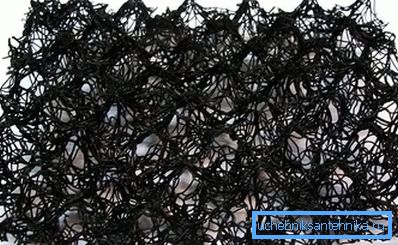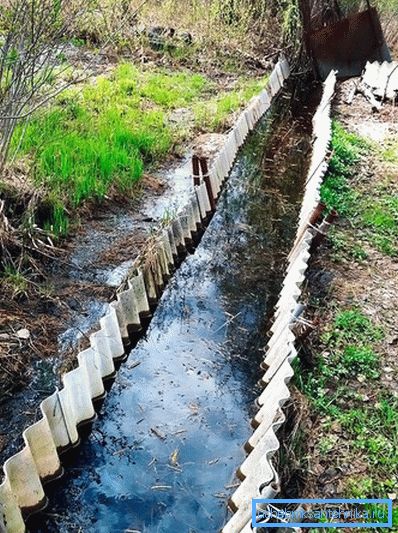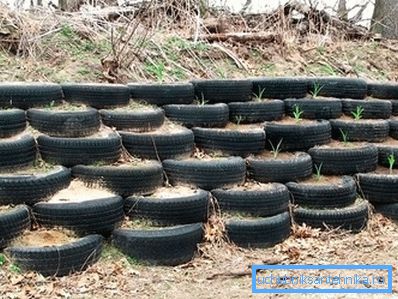How to strengthen the drainage ditch
Practically every household or summer house with a high level of groundwater is equipped with a drainage system. Such additional communications are necessary to divert excess water from the territory. Thus, they protect the site from flooding, and buildings on it - from destruction. Many drainage systems are made in an open way. Throughout the site a network of trenches is laid, with the help of which the water is drained. But in this case there is a difficulty, because you need to know how to strengthen the drainage ditch. What ways are there? This is what the article will be about.
Strengthened with factory products

Strengthening the walls of drainage ditches can be made with the help of various special products manufactured by manufacturers. For these works use the following devices:
- biomats or geomats;
- geonet;
- geogrids;
- gabions
The first three options are used with a slope of 8 to 15 °. If the walls of the ditch are steeper, then use geogrids or gabions.
Geomats or biomats are a kind of sponge made of several layers of polymer grids. Vegetation freely grows through this rolled material, thereby strengthening the walls of the drainage ditch even more reliably.
Geomats

Installation of geomats is quite simple. Initially, the slope is cleared of debris and large plants (shrubs and high grass). Then the surface must be leveled using a rake. After that, in the upper part of the slope, the edge of the geomat is fastened with anchors. Then the roll is rolled to the base of the slope and an extra piece is cut. The lower edge of the geomat is also attached with anchors. After that, by analogy, the next strip of material is laid. At the same time it is necessary to do an overlap of 15 cm.
After the entire slope is covered with a geomat, it is covered with soil (3-4 cm is enough). Then the surface is preferably sown with the seeds of grass plants. So, you improve the appearance and more firmly secure the material.
Geogrid

The geogrid is made in the form of a polymer grid with square cells. This material is the same as the previous one, is available in rolls. Its laying is similar to the strengthening of the walls of ditches with the help of a geomat. First, the slope is cleared and leveled. After that, the surface must be compacted using a hand roller. Then the grid is laid out and fixed, using anchor rods or metal brackets (at least 15–20 cm long).
The geogrid can be covered with soil (in this case, it is sown with the seeds of grass plants) or covered with small stones or rubble.
Geogrid

More robust and reliable material for strengthening the walls of the drainage ditch is a geogrid. Such products are made of durable polyethylene or polypropylene. The geogrid is attached to the slopes using anchor fasteners (L-shaped product, 50–80 cm long).
Drain the ditch before starting work. Then the slopes and the bottom is cleared of debris and leveled. After that the geogrid is laid out. Fastening is done in staggered order at a distance of 30-40 cm from each other. After that, all cells are covered with sand or gravel.
The most expensive, but also the most reliable strengthening of the slopes of drainage ditches is gabion. Such products are made in the form of a parallelepiped mesh. At the same time the metal wire of double weaving is used.
To protect against corrosion, the mesh is covered with a layer of plastic. Large stones or crushed stones are placed inside the gabion. Such protection can last more than 50 years. At the same time, the appearance of the gabion is very attractive.
We use the materials at hand

For work it is necessary to prepare some tools and materials. You will need:
- Slate (you can use any, even second-hand, as long as it does not have large holes).
- Metal pins or pipes with a length of 1 m.
- Bulgarian.
- Shovel.
- Scrap.
The first thing cut sheets of slate into identical pieces of the right size. Then, using a shovel, install them into the ground along the cleavage of the ditch, to a depth of 20–30 cm. Next, we drive in the rods or pipes on both sides of the slate. Such a strengthening of the slope does not look very attractive, and its service life is not great. But as a temporary solution may well come up.
In addition to slate, you can use old car tires. But this option is acceptable if there is enough space on the site. In this case, the tires are stacked on each other along the walls of the ditch. You can put each circle with an offset, in this case, the slope will be more gentle. Then the ground is poured inside the tires, and grass is sown over the top or small shrubs are planted.
After vegetation germination, the appearance of the slope will be close to the natural landscape. Car tires do not decompose, and, therefore, such a strengthening of the slopes will serve for a very long time.

Which option of strengthening the drainage system you choose, it is important to do all the work with high quality. In this case, the arrangement of the ditch will not have to do again. If you have any questions on this topic, then write them in the comments to the article. Maybe you have alternative ideas to strengthen the drainage of the ditch? Then share them with us by writing your opinion. Your experience will be very rewarding!
Video
If you do not have enough funds for the arrangement of the drainage system, do not despair! The video suggests a method of laying drainage from old tires, which you can repeat with your own hands without involving a specialist: